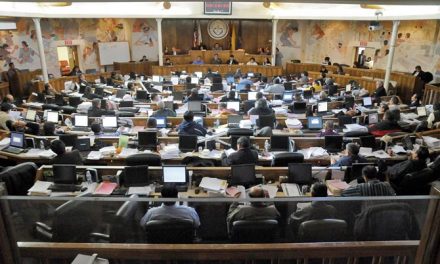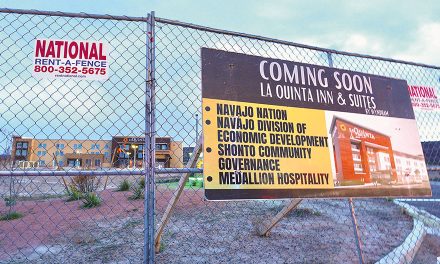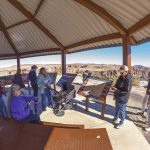
Letters | Betrayal of trust
Betrayal of trust
Editor,
An action by the president of the Navajo Nation on or about April 9, 2025, bothers me so much that I must write this letter of concern. It was that day President Nygren (shitsóí) visited Trump (Mr. Yellowhair) in D.C. What took shitsóí to D.C. was one of the many executive orders signed by Mr. Yellowhair, Executive 14241. This executive order is meant to “take immediate action to facilitate domestic mineral production to the maximum possible extent” on all federal lands, which includes Indian reservations. Navajo reservation included.
During his visit shitsóí complimented Mr. Yellowhair for the signing of the executive order aimed at revitalizing the coal industry and emphasizing the inclusion of tribal nations like the Navajo Nation. He further stated, “the harmful policies of the past have unfairly targeted coal, but those tides are turning. If the federal government is serious about increasing domestic energy production, enhancing permitting, and bolstering energy security, it must work in partnership with tribal nations (Navajo Nation).”
Shitsóí made a commitment that the doors to the Navajo are open to the federal government to accomplish the order. This statement sets everything in motion. The Department of Interior two weeks later develop and issued a policy stating it is implementing emergency permitting procedures to accelerate the development of domestic energy resources and critical minerals. The new policy is designed to expedite the review and approval of identification, leasing, siting, production, transportation, refining, or generation of energy on federal lands. The new permitting procedures will take only 28 days at most. The consultation with tribes under Section 106, National Historic Preservation Act which allow tribes to comment is reduced down to just 7 days.
Shitsóí never came to Dził Yíjiin or anywhere else to tell anyone of his plan to endorse the executive order and to seek opinions. Dził Yíjiin under Peabody coal operation loses and suffered so much and still have not recovered, especially water. We do not have a lake or river nearby. We only have underground water which Peabody wasted for the last 50 years. If another industry is brought in to produce energy for outside cities it will certainly destroy our livelihoods, it will take just about all our water. We are already experiencing water shortages.
Every chapter in Dził Yíjiin is acting on resolution “No Coal in Dził Yíjiin,” they are seeking to meet with Nygren to explain his action and demanding he retrack his endorsement, they also want to meet with the Speaker and members of the Navajo Nation Council seeking their understanding and support.
It appears shitsóí failed to uphold the Diné Fundamental Law. His endorsement seems to weaken the treaty and sovereignty of the Navajo Nation and the federal obligation.
Percy Deal
Big Mountain, Ariz.
Our water, their luxury
Editor,
To President Buu Nygren, Speaker Crystalyne Curley, and honorable members of the Navajo Nation Council:
Yá’át’ééh, shi éí Racheal James yinishyé, Tábąąhá nishłį, Honágháahnii bashíshchíín,
Tó Dík’ǫ́zhí dashicheii, Nakaii Dine’é da shi nálí, ákót’éego asdzání nishłį. My name is Racheal
James, and I’m from the community of Thoreau, New Mexico. I currently live and work in
Tucson, Arizona. Living in this growing and thriving city has led me to ask: how is it that Tucson continues to build and expand its infrastructure year after year while my home community – and so many others across the Navajo Nation – remain stagnant, or worse, in visible decline?
I am fully aware of the long and troubling history involving Peabody Energy, the Office of Surface Mining Reclamation and Enforcement (OSMRE), and the Mohave Generating
Station and how their operations disproportionately extracted vital resources from the Navajo Nation to fuel the development of distant cities like Tucson. One of the most egregious examples of this imbalance is the way Peabody Energy used our water – not to support our people, not for drinking, farming, or community needs, but simply as a means to transport coal more cheaply and conveniently of our land.
Peabody chose not to use trucks or trains to haul coal from the Black Mesa Mine to the Mohave Generating Station in Nevada. Instead, they pumped up to 3 million gallons of pristine groundwater per day from the Navajo Aquifer to create a coal slurry pipeline, a method selected for its cost efficiency, not its respect for our land or people. This water, sacred to and relied upon by both Navajo and Hopi communities, was sacrificed not for our benefit, but to make things easier and cheaper for a corporation operating far from accountability.
Now compare that to life in Tucson, where approximately 20% of homes have swimming pools. Each of those pools consumes about 30,000 gallons of water per year, roughly equivalent to the amount of water Peabody used in a single day to move coal out of Black Mesa. And this water use is purely recreational. No one is drinking from pools. No one is feeding their families from them. It is leisure, not survival.
This is not a minor detail. It highlights a deeply unjust system where Indigenous communities are expected to give up life-sustaining resources so that others can float in comfort. The water that was taken from the Navajo Aquifer to support industry is now mirrored by water used in cities like Tucson to support luxury.
To make matters worse, the community of Black Mesa has not recovered – and neither has the aquifer. So how does the Navajo Nation President and Council plan to address this injustice? By continuing to sign contracts with companies that have no love for our land, our people, or our way of life?
It surely will not be achieved by opening more mines, which take more than just natural resources. They take dignity, health, and the promise of a future. It surely will not be achieved by selling what we have left for peanuts. And it certainly will not be achieved by sending the message to this and future generations that our lives, our culture, and our sovereignty are expendable.
We must ask ourselves, and our leaders: When will the value of our people outweigh the profit made from our pain?
Racheal James
Thoreau, N.M.
Tucson, Ariz.
Building the future
Editor,
This is in response to the St. Michaels Indian School gymnasium groundbreaking on Thursday, May 22, at 10 a.m. I am encouraging all former students and alumni to attend the groundbreaking ceremonial for a new gym. Seeing you as a former student would be a wonderful and exciting visitation.
It was announced about four years ago that St. Michaels Indian School was going to build a new school gym. It was going to be located northwest of the school campus at the east end of the football field. The new 16,460-square-feet gym will be located east of the existing gym that was built 92 years ago.
The old gym did serve its purpose in providing students and community activities. Since I was an older student, I was assigned by Murray Lincoln, dorm advisor, to assist Bud Town and Sam Lincoln, the school carpenters with school repairs. We did a lot of roof repairs, replacing windows, sandpapering and gluing the floor of the gym. The gym capacity was about 1,500 people.
The Sisters of the Blessed Sacrament who operated the school for elementary, middle, and high school students did it without tiresome for many years before turning it to present Independent Indian School. They also planned and operated gymnasium activities that included: school graduations, school choirs, boys and girls tournaments, school bingos, school bazaars, PTAs and school board meetings, school assemblies, community basketball tournaments, Wingate Valley Boys dances, and Spelling Bee contests.
While waiting for the next assembly speaker, Bud Town and his daughter, Josephine Town, would perform a hoop dance to her father’s song and drum beat. The whole school was heated by a coal fired plant. Since the gym was furthest away, it would be cold during some activities.
I am not a school alumnus but only a former school student for over nine years at SMIS. However, I graduated from the Holy Cross Abbey School in Canon City, Colorado, in 1959.
I know some of you former and alumni are still kicking. Let’s all come and celebrate the school breaking ground for a new gymnasium on Thursday, May 22, at 10 a.m.
Irvin Jones
Gallup, N.M.
What the writer cannot see
Editor,
Nick House’s reporter’s notebook this week (May 8, 2025) is a little more overwritten than we’re used to in the Navajo Times.
Actually, it took two reporters’ notebooks to say that the paper plans an “unprecedented major investigative project” that’s going to, you know, tell us something we don’t know from people who don’t live here as if they know something we don’t.
Nick regales us “under the boundless desert sky” with a 1,620-word treatise to try to tell us what he wants to tell us without really telling us what he wants us to know. But at least he’s, y’know, enthusiastic about it.
He assures us “the tone in this pursuit is serious and powerful: a sense of responsibility, gravity, and purpose as vast as the land our people walk upon.”
That sounds important, a little like dinosaurs have been rediscovered.
I guess we’ll have to wait until he makes a few phone calls to really know what he’s talking about. But thank goodness, we pretty much already have the conclusions of this unprecedented investigation from his reporter’s notebook and graphic with glasses, so all we need now are quotes from important people “from coast to coast and outside the U.S. borders” to juice it up.
It will be worth the wait. We’re about to learn how “sovereignty without truth is rot disguised as strength.”
In the honored tradition of the logical fallacy, that means we can expect Nick to unveil how Navajo sovereignty is rotten because nobody tells the truth and everything’s disguised. Or something like that.
From his 1,600 flowery words, and his recitation of editor Krista Allen’s glowing, incomparable, peerless bona fides, it’s safe to say he’s got his editor’s full support to pursue the truth as he sees it. After all, she is “truly a martyr in journalism” who “gave voice to the silenced.” There must be awards for that.
At least Nick’s trying. It’s pretty heavy lifting in the news writing sense to use words like “portend” while “the night still clings to the west, offering comfort we can no longer afford” because he seeks to ask “an urgent question that echoes from the mesas that adorn the Four Corners.” That ASU poetry minor is making itself useful.
I can already see voluminous phrases from his unprecedented investigation emblazoned on T-shirts and sold as Navajo Times merch.
“Before the great discourse that shall ripple across Nihimá Nahasdzáán begins, we take this moment to revel, to honor the stillness before the storm of ideas.”
He’s just getting warmed up.
“The questions we ask will not fade – they will thunder through Wááshindoon, across council fires, and through every home where sovereignty still breathes.”
Well, he told ‘em.
Even though the recall fell flat, the vaunted, time-hallowed Navajo Times “is perched to pick up the gauntlet of righteousness, and those in power have been warned forsooth.”
I made up that one. I’m trying to sound like Nick.
“With plans to correspond with leaders from coast to coast, and outside the U.S. borders – a small but telling fraction of sovereign nations – to learn how Diné actions are perceived from afar and what they portend for Indian Country as a whole.” That’s Nick again.
Small but telling fraction, indeed. Yes, Nick House, the Shakespeare of the Navajo Times, is on the case. Can’t wait.
George Hardeen
Page, Ariz.








 Highway 264,
Highway 264, I-40, WB @ Winslow
I-40, WB @ Winslow